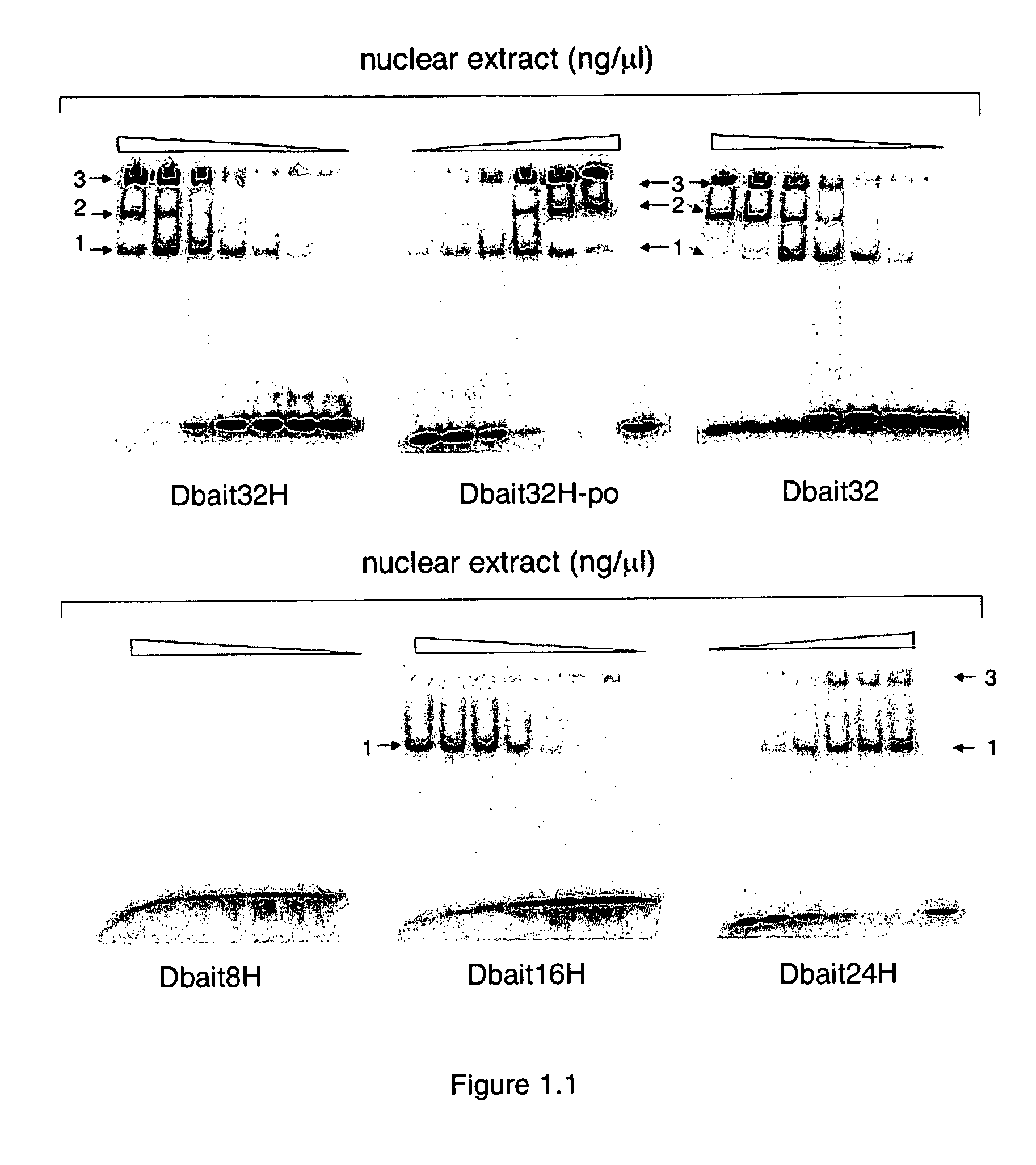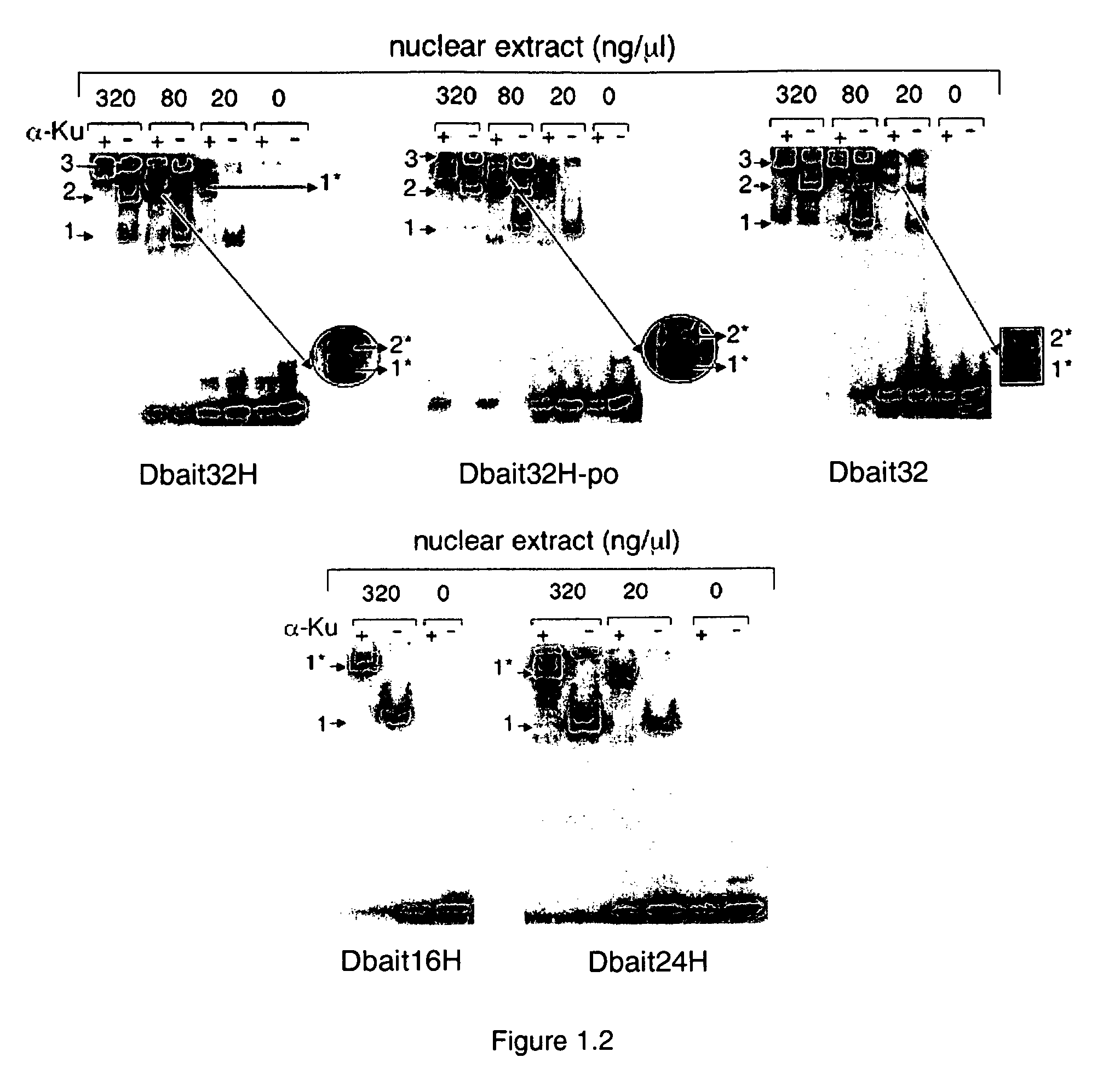Dbait and uses thereof
a technology of dbait and dbait, which is applied in the direction of drug compositions, peptide/protein ingredients, cardiovascular disorders, etc., can solve the problems of interfering with dna lesion sensing, signaling and/or repair processes, and achieve the effect of conferring or increasing the sensitivity of any tumor cell to dna, enhancing the sensitivity of cells to direct or indirect dna damaging therapies
- Summary
- Abstract
- Description
- Claims
- Application Information
AI Technical Summary
Benefits of technology
Problems solved by technology
Method used
Image
Examples
example 1
Design, Synthesis and Preparation of Dbait Molecules
[0116]Two types of Dbait molecules were designed: linear or hairpin dsDNA fragments. For hairpin Dbait molecules, a hexaethyleneglycol linker or a tetradeoxythymydylate was used as loop.
[0117]The end(s) of dsDNA stem can be protected against chemical degradation by 3′-exonucleases by the incorporation of phosphorothioates, methylphosphonates or 3′-3′nucleotide linkage. In principle, other chemical modifications can be used provided that they are compatible with Ku70 / Ku80 binding and DNA-PKcs activation (Martensson & Hammarten, 2002). Different Dbait molecules with various stem length 8 bp (Dbait8H) (SEQ ID NO: 4), 16 bp (Dbait16H) (SEQ ID NO: 3), 24 bp (Dbait24H) (SEQ ID NO: 2) and 32 bp (Dbait32H) (SEQ ID NO: 1), as well as different stem sequences were assayed. A dumbell dsDNA fragment (Dbait32C) (SEQ ID NO: 1) where both ends were sealed by two hexaethylene loops was also designed, as control. Some Dbait molecules were labelled ...
example 2
Biochemical Analysis of Dbait Molecules
[0134]As the first step to dissect the mechanism of action of Dbait molecules, a series of band-shift assays were carried out with different 32P radio-labelled Dbait molecules in the presence of nuclear protein extracts from Hep2 cells according to standard protocol. Typically, 10 nM 32P radio-labelled Dbait molecules were incubated in the presence of various concentrations of nuclear proteins (0, 10, 20, 40, 80, 160, and 320 ng / μL) at 30° C. for 10 minutes in TBE buffer. Then the samples were loaded on a 5% acrylamide native gel. The electrophoresis was run at 95V for 2 hours at 4° C. The gel was dried and scanned by phosphorimager (Molecular Dynamics).
[0135]FIG. 1.1 shows the retarded band pattern of the titration of Hep2 nuclear protein extracts with various Dbait molecules of different lengths. Except the shortest 8 bp long Dbait molecule (Dbait8H) (SEQ ID NO: 4), up to 2 retarded bands were observed for longer Dbait molecules: One retarded...
example 3
In Vitro Activity of Dbait Molecules
[0144]The activity of Dbait molecules in cultured cells was studied by clonogenic survival assay in two radio-resistant human cancer cell lines derived from a female cervix carcinoma (HeLa) and from HNSCC (Hep2) in association with ionizing radiation, by the inhibition of illegitimate integration of exogenous DNA fragment and by detecting the persisting DSB foci after irradiation in the cells transfected by Dbait molecules.
[0145]Established human cell lines Hep2 (head and neck squamous cell carcinoma, HNSCC), LU1205 and SK28 (melanomas) were used for animal studies. Studies of cells in culture were performed using Hep2, HeLa S3 (epithelia cervical carcinoma), MO59K and MO59J (glioblastoma). Cells were grown at 37° C. in monolayer cultures in complete DMEM containing 10% heat-inactivated fetal bovine serum (FBS; Invitrogen, Cergy Pontoise, France) and antibiotics (100 μg / ml streptomycin and 100 μg / ml penicillin) under conditions of 100% humidity, 9...
PUM
| Property | Measurement | Unit |
|---|---|---|
| temperature | aaaaa | aaaaa |
| concentrations | aaaaa | aaaaa |
| concentrations | aaaaa | aaaaa |
Abstract
Description
Claims
Application Information
 Login to View More
Login to View More - R&D
- Intellectual Property
- Life Sciences
- Materials
- Tech Scout
- Unparalleled Data Quality
- Higher Quality Content
- 60% Fewer Hallucinations
Browse by: Latest US Patents, China's latest patents, Technical Efficacy Thesaurus, Application Domain, Technology Topic, Popular Technical Reports.
© 2025 PatSnap. All rights reserved.Legal|Privacy policy|Modern Slavery Act Transparency Statement|Sitemap|About US| Contact US: help@patsnap.com



